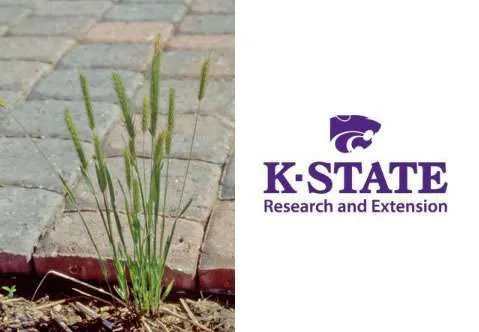[email protected]
HNR Website access: https://hnr.k-state.edu/extension/horticulture-resource-center/horticulture-newsletter/
Horticulture 2024 Newsletter
No. 24 June 17, 2024
1712 Claflin, 2021 Throckmorton Plant Science Center
Manhattan, KS 66506 (785) 532-6173
ANNOUNCEMENTS
Riley County Master Gardener 35th Annual Garden Tour
Saturday, June 22, 2024
8:30-1:00
For more information contact: 785-537-6350
2024 Kansas Turf and Ornamentals Field Day
August 1, 2024, at Rocky Ford Turfgrass Research Center in Manhattan, KS. https://www.k-state.edu/turf/events/2024TurfFieldDayProgram.pdf
VIDEO OF THE WEEK:
Common Tomato Problems, Part 2
Tomatoes are one of the most popular vegetables to grow, but there are several things that may cause problems — including insects, sunburn, calcium deficiency, and cracking. This segment shows examples and gives advice on how to correct some of the issues.
GARDEN TO-DO
Renovate strawberry beds after last picking of fruit by cutting off leaves, fertilizing and narrowing row to 10 inches.
Plant Fall Squash and Pumpkins
Tip blackberries, black raspberries and purple raspberries as needed.
PESTS
Squash Bugs
Description: Eggs are 1/16-inch in diameter and change from light brown to dark red. Young nymphs are pale green with red antennae which later turn black. As the nymphs develop, they turn a light to dark grey color. Mature nymphs are up to ½-inch long and wingless. Adults are ½ to ¾-inch long and dark-brown in color. The wings are brownish-black with orange markings on the outer edge of the body. If crushed, adult squash bugs emit a foul odor.
Life Cycle: Squash bugs overwinter as adults. From late-May through June they seek a plant host. From June through mid-August, after mating, females lay eggs in clusters on the stems and undersides of leaves. Within 7 to 14 days nymphs hatch and go through multiple stages of development. By 4-6 weeks, the adult squash bug is fully developed.
Damage: The primary hosts for squash bugs include summer/winter squash and pumpkins but they will feed on other cucurbits as well. Adults and nymphs have piercing-sucking mouthparts which they use to suck fluids from leaves, stems and fruits. Young plants are at a great risk for destruction from squash bugs, though mature plants can be severely damaged as well if the pest population is high. Damage appears as small yellow specks on leaves. Stem damage causes wilting and leaves will dry up and shrivel. Feeding on fruit affects the quality by causing distortion and scarring along with sunken areas.
Control: Preventative management is the best recommendation. Scout for pests in the garden regularly. Look on the undersides of leaves and the stems for eggs early in the season. Remove plant debris to reduce overwintering habitats. Physically remove and destroy eggs, nymphs and adult bugs from plants as you find them. Use floating row covers, if garden size allows, to exclude pests from accessing plants.
Horticulture oils can be effective if applied on eggs. Young nymphs can be controlled with insecticides. Weekly application may be necessary for complete control. Adult squash bugs have a thick, waxy cuticle that makes insecticides ineffective. Ensure thorough coverage of the plant for best results. See your local extension agent or KSRE Publication: Squash Bugs for insecticide recommendations.
For more information about squash bugs see KSRE Publication: Squash Bug
Hornworms on Tomatoes
Description: The larval stage is a 3 ½ to 4-inch long pale, green caterpillar. There are five pairs of prolegs and a horn on the last segment. The tobacco hornworm has seven diagonal white stripes and usually a red horn. The tomato hornworm has V-shaped markings and a blue/black horn. The adult moth has a stout, grayish-colored body with wings that span 4 to 5 inches.
Life Cycle: In the larval stage the hornworm caterpillar passes through four or five stages before reaching full size. This process takes about one month. The caterpillar pupates in the soil giving rise to an adult moth. The adult of the tobacco hornworm is the Carolina sphinx moth. The adult of the tomato hornworm is the five-spotted hawk moth. There are two generations each year.
Damage: Hornworm larva are the damaging stage and are typically found on tomatoes, but feed on eggplant, peppers and potatoes as well. Caterpillars devour leaves and stems leaving behind dark green or black droppings.
Control: Hornworms are parasitized by several insects including the small braconid wasp which lays eggs on the larva. When the eggs hatch, the wasp larva feed on the hornworm devouring it from the inside killing the hornworm.
To avoid harming beneficial insects, handpicking hornworms is the recommended control. Hornworms camouflage themselves among the leaves making it difficult to find them.
Bt (Dipel, Thuricide), Spinosad (Conserv, Captain Jack’s Dead Bug Brew, Monterey Garden Insect Spray), cyfluthrin (BioAdvanced Vegetable & Garden Insect Spray) are a few insecticides that can be effective at controlling hornworms. Always follow label instructions and pay close attention to the harvest interval.
TURF
Grub Control in Lawns
If you’ve dealt with an excessive number of grubs in the lawn previously you may choose to apply a pesticide containing imidacloprid. This active ingredient is safe and effective at killing the grubs before they damage plant roots. Apply the product by mid-July and water it in if rain is not expected within 24 hours.
Controlling Yellow Nutsedge in Lawns
We are getting numerous requests for weed identification in lawns and landscapes which is common this time of year. Yellow nutsedge often appears when the soil is moist. Some identifying features of yellow nutsedge include:
Yellow inflorescence
Yellow-pale green leaves
Tapered leaves with sharp point
Triangular stem with leaves growing in three directions
Rapid growth extending above the turfgrass within days of mowing.
The best control of yellow nutsedge is maintaining a healthy, dense lawn. Nutsedge spreads by tubers which can produce numerous plants. Manually pulling yellow nutsedge can activate dormant tubers which send up new growth, but with persistence over multiple seasons it can be eradicated. If using an herbicide, it is important to apply before tuber production for the best control. The first application should usually be applied by June 21 before plants mature. Here are some herbicide options for home gardeners.
SedgeHammer and Hi-Yield Nutsedge & Horsetail Control (active ingredient: halosulfuron)
Bonide Sedge Ender, Ortho Nutsedge Killer & Spectracide Weed Stop for Lawns plus Crabgrass Killer (active ingredient: sulfentrazone)
Always follow label instructions and pay attention to turfgrass species tolerance for herbicide treatments.
VEGETABLES
Tomato Leaf-Spot Diseases
Septoria Leaf Spot appears initially as small, water-soaked spots on the lower leaves. The centers of the spots turn light tan or gray while the margins remain dark. Dark-colored fungal fruiting structures form in the spots which are typically smaller and more numerous than early blight spots.
Early Blight symptoms appear as irregular, brown lesions or spots on the leaves up to ½-inch in diameter. The dark, concentric rings in the lesions give the spots a target-like appearance. This is a distinguishing symptom to identify the disease. Several lesions can merge together and cause the leaf to yellow, dry up and drop prematurely. Leaf drop reduces the plant’s ability to photosynthesize thus reducing the energy and vigor of the plant. It can also expose fruit to an increased risk of sunscald. Early blight lesions can develop on the stem and fruit as well.
In Kansas, Septoria leafspot tends to be more common than early blight. Both fungi overwinter in plant debris, on seeds or weeds. Spores can splash or blow onto tomato plants. Warm, humid weather and heavy rainfall favor development of Septoria leafspot and early blight.
Read more at our KSRE Publication: Early Blight and Septoria Leaf Spot
PERMACULTURE
Growing With Microclimates
Working with the environment is a core principle of permaculture. Learn how to take advantage of microclimates to support optimal plant health and get more out of your growing spaces.
Read more in our KSRE publication:
Growing with Microclimates
QUESTION of the WEEK
Cleaning up Asparagus
I have finished harvesting my asparagus. When should I remove the tops off the plants?
Asparagus tops should not be removed until after a killing freeze. The tops have the important role of producing and transferring food to the plant roots impacting next year’s growth. If plants are falling over and you want them to remain upright, set posts 10-12 feet apart and secure plants with twine.
Contributors:
Cynthia Domenghini, Instructor and Horticulture Extension Specialist
K-State Plant Pathology
K-State Entomolgy
K-State Turf and Landscape Blog
Kansas Garden Guide
Division of Horticulture
1712 Claflin, 2021 Throckmorton
Manhattan, KS 66506
(785) 532-6173
For questions or further information, contact: [email protected] OR [email protected]
This newsletter is also available on the World Wide Web at:
http://hnr.k-state.edu/extension/info-center/newsletters/index.html
The web version includes color images that illustrate subjects discussed. To subscribe to this newsletter electronically, send an e-mail message to [email protected] or [email protected] listing your e-mail address in the message.
Brand names appearing in this newsletter are for product identification purposes only. No endorsement is intended, nor is criticism implied of similar products not mentioned.
K-State Research and Extension is committed to making its services, activities and programs accessible to all participants. If you have special requirements due to a physical, vision or hearing disability, or a dietary restriction please contact Extension Horticulture at (785) 532-6173.
Cynthia Domenghini, Ph.D.
Instructor; Horticulture Extension Specialist
Department of Horticulture and Natural Resources
Kansas State University
1712 Claflin Rd.
Manhattan, KS 66503
785-340-3013
[email protected]





